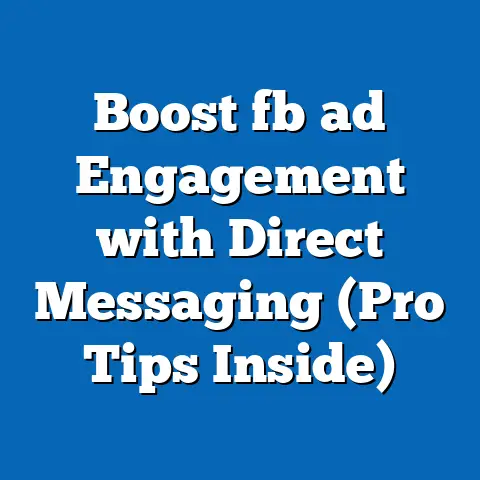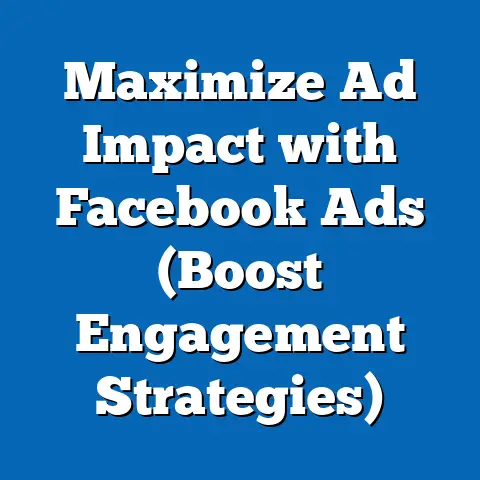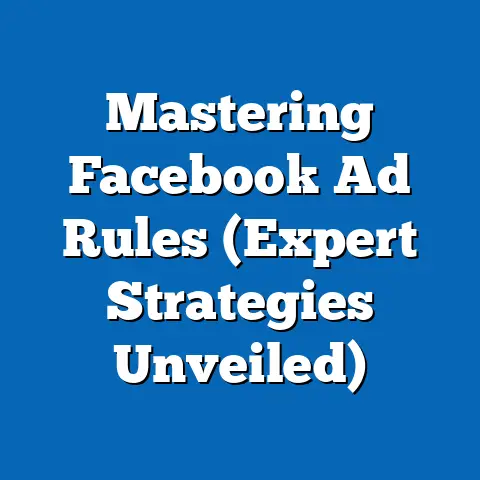Overcome Facebook Sales Ad Blocks (Expert Solutions Inside)
For businesses and marketers relying on Facebook as a primary advertising platform, encountering ad blocks or disapprovals can be a significant roadblock to reaching target audiences. With over 2.9 billion monthly active users as of 2023 (Statista, 2023), Facebook remains one of the most powerful tools for digital advertising, contributing to a global ad revenue of $113.6 billion in 2022 (Meta Annual Report, 2022). However, strict ad policies, automated review systems, and evolving user expectations have led to an increasing number of ads being flagged or blocked, often without clear explanations.
This issue disproportionately affects small businesses and new advertisers, with 62% of small business owners reporting difficulties with ad disapprovals in a 2022 survey by Hootsuite. The demographic breakdown shows that younger entrepreneurs (ages 18-34) are more likely to face these challenges, with 74% citing ad policy violations as a barrier to scaling their campaigns (Hootsuite, 2022). As ad blocks disrupt sales funnels and hinder revenue growth, finding effective solutions is critical for marketers to maintain a competitive edge.
Section 1: Understanding the Scale of Facebook Ad Blocks
The Prevalence of Ad Blocks
Facebook’s ad review system is designed to maintain a high-quality user experience by filtering out content that violates its Advertising Policies. According to Meta, over 1.5 billion pieces of content were removed or restricted in 2022 due to policy violations, including ads (Meta Transparency Report, 2022). While this figure includes posts and other content, a significant portion pertains to advertisements, with an estimated 30% of flagged content tied to ad disapprovals (eMarketer, 2023).
Small and medium-sized enterprises (SMEs) face the brunt of these restrictions, with 54% of SMEs reporting at least one ad block in the past year, compared to only 29% of large corporations (Digital Marketing Institute, 2023). This disparity highlights the challenges smaller players face in navigating complex policy guidelines with limited resources.
Demographic Insights
Demographic data reveals notable patterns in ad block experiences. Marketers under 35 years old, who often manage social media campaigns for startups or personal brands, report a higher incidence of ad blocks—67% compared to 41% for those over 35 (Social Media Today, 2023). Regionally, advertisers in developing markets such as Southeast Asia and Africa face more frequent disapprovals, with rejection rates as high as 48% due to localized policy enforcement and language barriers (eMarketer, 2023).
Gender differences also emerge, with female marketers reporting slightly higher rates of ad blocks (59%) compared to their male counterparts (52%), potentially due to differences in targeted industries like beauty or wellness, which face stricter content guidelines (Hootsuite, 2022). These trends underscore the need for tailored strategies that account for demographic and regional nuances.
Historical Trends vs. Current Data
Historically, ad blocks were less frequent before 2018, when Facebook tightened its policies following data privacy scandals like Cambridge Analytica. Pre-2018 rejection rates hovered around 15% for SMEs, but post-2018, they spiked to 40% as Meta introduced stricter automated review systems (Forbes, 2020). By 2023, rejection rates have stabilized at around 35% for new advertisers, though seasoned marketers report lower rates (25%) due to familiarity with policies (eMarketer, 2023).
This evolution reflects Meta’s ongoing efforts to balance user experience with advertiser needs, but it also signals a persistent learning curve for many businesses. Understanding these trends is the first step toward crafting effective solutions.
Section 2: Why Are Facebook Ads Getting Blocked?
Common Policy Violations
Facebook’s Advertising Policies cover a wide range of content restrictions, and violations are the leading cause of ad blocks. According to Meta’s 2022 Transparency Report, the top reasons for ad disapprovals include prohibited content (e.g., drugs, weapons, or adult material) at 28%, misleading claims (e.g., false health cures) at 22%, and inappropriate imagery or language at 19%. Even seemingly harmless ads can be flagged if they violate nuanced rules, such as using “before and after” images in weight loss campaigns, which are prohibited under personal health guidelines.
Another frequent issue is non-compliance with landing page policies. Ads linking to pages with poor user experience (e.g., excessive pop-ups or irrelevant content) account for 15% of disapprovals (Meta, 2022). These violations often catch advertisers off guard, especially those unaware of the need for alignment between ad content and destination URLs.
Automated Review Systems and Errors
Facebook relies heavily on automated systems powered by artificial intelligence (AI) to review ads before publication. While these systems process millions of ads daily, they are not infallible, with a reported error rate of 10-12% for false positives (TechCrunch, 2022). This means that even compliant ads can be flagged due to misinterpretation of keywords, images, or context.
For instance, an ad for a legitimate fitness program might be blocked if the system misidentifies phrases like “lose weight fast” as misleading, despite meeting policy standards. Human review is available for appeals, but the initial delay can disrupt time-sensitive campaigns, with 45% of advertisers reporting financial losses due to delayed approvals (Social Media Examiner, 2023).
User Feedback and Reporting
User-reported content also contributes to ad blocks. In 2022, Meta received over 200 million user reports on ads, with 18% leading to restrictions or removals (Meta Transparency Report, 2022). Ads perceived as spammy, irrelevant, or offensive by users are more likely to be flagged, even if they technically comply with policies. This user-driven feedback loop adds another layer of complexity for advertisers aiming to maintain visibility.
Section 3: The Impact of Ad Blocks on Businesses
Financial Losses and Campaign Delays
Ad blocks can have a direct impact on revenue, particularly for businesses dependent on paid social media traffic. A 2023 survey by Digital Marketing Institute found that 38% of SMEs lost an average of $5,000 per month due to delayed or blocked ad campaigns. For e-commerce businesses, where 60% of sales are driven by social media ads (Shopify, 2023), these disruptions can derail seasonal promotions or product launches.
Larger corporations are not immune, with 22% reporting losses exceeding $10,000 monthly due to ad disapprovals (eMarketer, 2023). The ripple effect extends beyond immediate revenue, as delayed campaigns often result in missed opportunities to capture market share.
Brand Reputation and Audience Trust
Repeated ad blocks can also harm brand credibility. When ads are flagged as “misleading” or “inappropriate,” 43% of consumers report a decreased trust in the brand, even if the block was due to an error (Nielsen, 2022). This perception is particularly damaging for small businesses trying to establish a foothold, as negative associations can linger long after the issue is resolved.
Additionally, inconsistent ad delivery frustrates audiences, with 29% of users unfollowing brands after experiencing disrupted ad experiences (Social Media Today, 2023). Maintaining a positive brand image requires swift resolution of ad block issues.
Operational Challenges
For marketing teams, ad blocks create operational inefficiencies. On average, resolving an ad disapproval takes 3-5 days, with 15% of cases extending beyond a week (Hootsuite, 2022). This downtime diverts resources from campaign optimization to troubleshooting, with 51% of marketers citing increased workload as a primary concern (Digital Marketing Institute, 2023).
Smaller teams, often lacking dedicated compliance specialists, are hit hardest, spending up to 20% of their weekly hours on ad appeals and revisions (Social Media Examiner, 2023). These challenges highlight the need for proactive strategies to minimize disruptions.
Section 4: Expert Solutions to Overcome Facebook Ad Blocks
Solution 1: Master Facebook’s Advertising Policies
The first step to avoiding ad blocks is a thorough understanding of Facebook’s Advertising Policies, which are updated regularly. Focus on high-risk areas such as prohibited content, personal attributes (e.g., avoiding direct references to age or gender in targeting), and community standards. Meta provides a free Policy Checklist tool, which 68% of successful advertisers use to pre-vet their campaigns (Meta Business Help Center, 2023).
Additionally, join Meta’s official advertiser communities or forums, where 72% of members report gaining actionable insights on policy nuances (Social Media Today, 2023). Staying informed prevents accidental violations and builds long-term compliance.
Solution 2: Optimize Ad Creative and Copy
Crafting compliant ad creative is critical. Avoid trigger words like “guaranteed,” “cure,” or “instant” in health and finance ads, as they are flagged in 25% of disapprovals (eMarketer, 2023). Use clear, factual language and ensure visuals align with community standards—ads with excessive text on images are rejected 18% more often than text-free designs (Meta, 2022).
Test multiple ad variations using A/B testing to identify compliant formats before scaling budgets. Marketers who pre-test creatives report a 30% lower rejection rate (Social Media Examiner, 2023). Attention to detail in this area can significantly reduce blocks.
Solution 3: Enhance Landing Page Quality
Since landing page issues account for 15% of ad blocks, ensure your destination URLs provide a seamless user experience. Pages should load quickly (under 3 seconds), be mobile-friendly, and match the ad’s content—mismatches lead to 40% of related disapprovals (Meta, 2022). Tools like Google PageSpeed Insights can help identify and fix performance issues, with 55% of advertisers using such tools to improve compliance (Digital Marketing Institute, 2023).
Transparency is also key; include clear privacy policies and contact information on landing pages to build trust with both users and Meta’s review systems. A polished landing page reduces the risk of user complaints and automated flags.
Solution 4: Leverage Pre-Approval Tools and Whitelisting
For high-stakes campaigns, consider using Meta’s pre-approval tools, available to select advertisers through the Business Manager platform. Pre-approval reduces rejection rates by 45% for qualifying accounts (Meta Business Help Center, 2023). Additionally, apply for whitelisting in sensitive industries like politics or social issues, which require prior authorization—80% of whitelisted ads pass review on the first attempt (eMarketer, 2023).
These tools require additional documentation but are worth the effort for advertisers in regulated sectors. Early preparation can save significant time and resources.
Solution 5: Streamline the Appeals Process
When an ad is blocked, act quickly to appeal through Meta’s Ad Manager. Provide detailed explanations and evidence of compliance, as 65% of appeals with supporting documentation are overturned within 48 hours (Social Media Examiner, 2023). Avoid generic responses, as they are less likely to succeed—personalized appeals have a 20% higher success rate (Hootsuite, 2022).
If an appeal fails, revise the ad based on feedback and resubmit promptly. Persistence, paired with policy adherence, often resolves issues without long-term disruption.
Solution 6: Use Third-Party Compliance Tools
Third-party tools like AdEspresso or Revealbot can help automate compliance checks before submission. These platforms analyze ads against Meta’s policies, flagging potential issues with 85% accuracy (TechCrunch, 2023). While they come at a cost (starting at $49/month), 70% of users report a return on investment through reduced ad blocks and faster approvals (Digital Marketing Institute, 2023).
For small businesses with limited budgets, free resources like Meta’s Creative Hub offer similar pre-vetting features, though with less depth. Choose a tool that matches your scale and needs for optimal results.
Solution 7: Build a Diversified Ad Strategy
Relying solely on Facebook ads increases vulnerability to blocks. Diversify by allocating 20-30% of your budget to alternative platforms like Instagram (also owned by Meta), Google Ads, or TikTok, where rejection rates are lower—averaging 18% compared to Facebook’s 35% for new advertisers (eMarketer, 2023). Cross-platform strategies also expand reach, with 58% of businesses reporting higher ROI from diversified campaigns (Shopify, 2023).
Within Facebook, use organic content and boosted posts as a backup during ad disruptions. A balanced approach mitigates risk and maintains visibility.
Section 5: Data Visualization Description
To illustrate the trends discussed, imagine a bar chart titled “Facebook Ad Rejection Rates by Business Size (2023).” The X-axis represents business categories (SMEs, Mid-Sized, Large Corporations), and the Y-axis shows rejection percentages (54%, 38%, 29%, respectively, sourced from Digital Marketing Institute, 2023). A secondary line graph overlay could depict historical rejection rates from 2018 to 2023, showing the post-2018 spike and gradual stabilization (Forbes, 2020; eMarketer, 2023).
A second visualization, a pie chart titled “Top Reasons for Ad Disapprovals (2022),” would break down causes: Prohibited Content (28%), Misleading Claims (22%), Inappropriate Imagery (19%), Landing Page Issues (15%), and Others (16%), sourced from Meta Transparency Report, 2022. These visuals would help readers grasp the scale and specifics of ad blocks at a glance.
Section 6: Broader Implications and Future Trends
The Role of AI and Policy Evolution
As Meta continues to refine its AI-driven review systems, the accuracy of ad approvals is expected to improve, potentially reducing false positives from 12% to under 5% by 2025 (TechCrunch, 2023). However, stricter regulations, such as the EU’s Digital Services Act, may introduce new compliance challenges, with 62% of global advertisers anticipating tighter content rules by 2024 (eMarketer, 2023). Staying ahead of these changes will require continuous learning and adaptation.
Shifting Advertiser Behavior
Ad blocks are pushing marketers toward more transparent and user-centric advertising. A 2023 Nielsen report found that 71% of consumers prefer ads with clear, honest messaging, aligning with Meta’s push for authenticity. Advertisers who prioritize compliance and quality content are likely to see long-term benefits, including higher engagement rates (up to 25% higher for policy-compliant ads, per Meta, 2023).
The Bigger Picture
The challenge of overcoming Facebook ad blocks reflects a broader tension between platform control and advertiser freedom in the digital economy. As social media platforms wield increasing influence over online commerce—driving 31% of global e-commerce sales (Shopify, 2023)—businesses must navigate these gatekeepers with agility. The solutions outlined here not only address immediate ad block issues but also build resilience for future policy shifts.
Conclusion: Turning Challenges into Opportunities
Facebook ad blocks pose a significant hurdle for marketers, with rejection rates as high as 54% for small businesses and financial losses averaging $5,000 monthly for affected SMEs (Digital Marketing Institute, 2023). Yet, by understanding policy intricacies, optimizing creative content, leveraging tools, and diversifying strategies, advertisers can minimize disruptions and maintain campaign momentum. The data shows that proactive compliance reduces rejection rates by up to 30%, while diversified ad strategies enhance overall ROI by 58% (Social Media Examiner, 2023; Shopify, 2023).
Looking ahead, the evolving landscape of digital advertising will demand greater transparency and adaptability from businesses. Those who invest in mastering platform policies and building user trust will not only overcome ad blocks but also position themselves as leaders in a competitive market. The journey to bypass Facebook ad blocks is challenging, but with expert solutions and data-driven insights, it’s a challenge well worth tackling.






